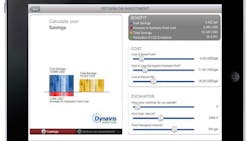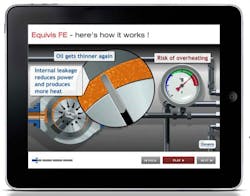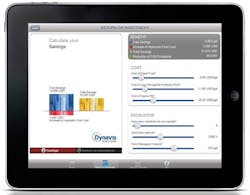With today's high fuel prices, it is necessary for machine operators and fleet managers to find new ways to curb their use of diesel. A new high-performance hydraulic fluid developed with Dynavis Technology from Evonik Oil Additives, Darmstadt, Germany does just this. Branded Equivis FE by Total Lubricants Co., of France, the new multi-grade hydraulic fluid has been distributed globally since the start of this month, with a focus on markets in Africa, Asia-Pacific and South America.
Equivis FE hydraulic fluid offers many benefits, most important being fuel economy. Hydraulic fluids formulated with Dynavis Technology have proven in a series of field tests to reduce fuel consumption approximately 5 to 30%.
“One of the primary beneficiaries of the fuel savings are operators of fleets of construction equipment, such as excavators and wheel loaders,” explains Dynavis Technology marketing manager Dr. Oliver Eyrisch. “With today’s relatively high costs for diesel fuel, Dynavis Technology opens the door to savings well into the six-figure range for operators of large fleets of equipment."
More power, less fuel
Dynavis Technology saves fuel and preserves hydraulic power by reducing a power-sapping phenomenon in hydraulic fluid pumps known as “internal leakage.” All types of hydraulic pumps are vulnerable to internal leakage, which occurs to a greater or lesser extent depending on working conditions.
Internal leakage in a pump typically occurs after several hours of hard work when hydraulic oil becomes hot. Ordinary monograde hydraulic fluids become thinner and “backwash” through pump vanes or pistons, instead of moving in the intended direction. The result is a noticeably sluggish and delayed response to the equipment operator’s commands. In fact, the unwanted recirculation caused by internal leakage compounds the problem by further increasing friction and adding more heat to an already hot fluid.
When internal leakage occurs, the pump operator tries to compensate for the lost power by stepping on the gas pedal, or increasing fuel consumption (also known as "afternoon slump"). Unfortunately, this tends to make matters worse, as the additional friction of the oil forced through the pump's narrow sealing gaps causes the fluid to become even hotter. The hydraulic system's performance continues to deteriorate into a vicious cycle of increased recirculation and higher operating temperatures — until the fluid is so overheated that vapor locks develop, and the entire hydraulic system comes to a halt.
Evonik says that Equivis FE can maintain the stability of the power output of the hydraulic pump, even after many hours of work under maximum load. Equipment can complete more load cycles and/or realize dramatic fuel savings. Broadened equipment temperature operating range also reduces normal wear. Even the normal wear and tear of seals and other hydraulic components is expected to be diminished.
Maintaining viscosity in fluctuating temps
Hydraulic fluids formulated with Dynavis technology are designed to perform consistently and reliably within a wide range of temperatures, from cold to hot. It ensures that hydraulic fluids exhibit lower viscosity at cold temperatures and deliver stay-in-grade viscosity performance when operating hot. They maintain high viscosity even at high temperatures, so the amount of recirculating oil is kept to a minimum, thereby keeping heat accumulation in check. In short, pump performance is maintained even during maximum power output.
Even at low temperatures, Dynavis formulated hydraulic fluids continue to minimize friction and wear, and reduce fuel consumption. If viscosity is too high in the start-up of hydraulic equipment, more power is required by the pump to move the fluid. In a comparison of conventional hydraulic fluids to Dynavis-formulated fluids, they demonstrated an ability to effectively and economically "start" at lower operating temperatures than the conventional fluids. Less power is required to move the pump, thereby saving fuel. Another benefit is reduced "wear and tear" on all hydraulic components, as the normally extreme friction of cold conventional hydraulic fluids is absent in the presence of the Dynavis formulated fluid.
The proof's in the pudding
In its field tests on bucket excavators, Evonik's Dynavis formulated fluids proved more fuel efficent and productive than machines running Monograde ISO 46 fluids. For example, the machines saw a 5% savings in fuel per cycle; up to 33% more buckets per liter of fuel; and up to 36% more buckets per cycle.
For more information on Dynavis, including a calculator to determine fuel savings, and more, visit www.dynavis.com. See a movie of the Dynavis field trial now.
About the Author

Leaders relevant to this article:



